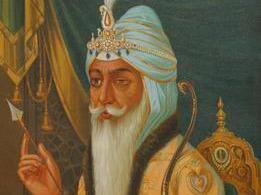Remembering the Sikh empire's first Maharaja

The anniversary of Maharaja Ranjit Singh's passing was observed last week
Indian Weekender correspondent Raghbir Singh writes a tribute
The Rise of the Sikh Empire
The Sikh Empire, commonly known as Khalsa Raj, straddled the border between modern-day People's Republic of China and Afghanistan. Maharaja Ranjit Singh, the first Maharaja of the Sikh Empire, holds a revered place in the history of Punjab and the Sikhs. His father, Maha Singh Sandhawalia, was the commander of the Shukerchakia Misl. Ranjit Singh succeeded his father at the young age of 12, and after several campaigns, united the various Sikh factions into one state. On April 12, 1801 (Baisakhi day), he took the title of Maharaja, with Lahore as his capital from 1799.
A Modern Visionary Leader
Maharaja Ranjit Singh was the first Asian ruler to modernise his army to European standards. He filled leadership positions in his Darbar with men of varied religions, reflecting his inclusive vision. His formidable military machine helped him carve out and maintain an extensive kingdom amid hostile and ambitious neighbours.
Observing the discipline and training of British troops, he recognised the importance of a well-drilled infantry and artillery. In 1802, soon after his occupation of Amritsar, he hired deserters from the East India Company to train his own platoons. Later, he employed two Napoleonic war veterans to raise a special corps, and even a Hungarian physician to oversee gunpowder manufacture.
This vision created Asia’s only modern army of the time, strong enough to halt the British advance at the Sutlej River. The British were forced to sign a treaty and not interfere in the Khalsa Empire, making the Sutlej the international border between the two powers.
Legacy of the Lion of Punjab
Maharaja Ranjit Singh is listed among the "Undefeated Military Commanders" at Wikibin, recognised for never losing a significant engagement as commander-in-chief.
A devoted admirer of Guru Gobind Singh, the Maharaja promoted the teachings of the Dasam Granth and built two of Sikhism’s most sacred temples: Takht Sri Patna Sahib (birthplace of Guru Gobind Singh) and Takht Sri Hazur Sahib (his final resting place in Nanded, Maharashtra). At the Harmandir Sahib in Amritsar, much of the present gilding and marble work was commissioned under his patronage.
The Decline of the Sikh Empire
Maharaja Ranjit Singh reigned for forty years until his death in 1839. His eldest son, Kharak Singh, inherited the throne but lacked the ability to rule such a vast empire. Internal conflict, weak leadership, and political conspiracies caused the empire to crumble. In 1845, after the First Anglo-Sikh War, the empire was defeated and major decisions came under the British East India Company’s control.
His youngest son, Duleep Singh, was crowned in 1843. By 1849, after the Second Anglo-Sikh War, Punjab was annexed by the British. The young Maharaja was taken to England, tricked into converting to Christianity at 13, and stripped of his inheritance — including the famous Kohinoor diamond.
End of a Dynasty
Upon reuniting with his mother in adulthood, Duleep Singh reconverted to Sikhism and petitioned the Crown for the return of his kingdom, but his pleas went unanswered. He died in Paris in 1893, never regaining his throne.
A Golden Period Remembered
The rule of Maharaja Ranjit Singh is remembered as the Golden Period of Punjab — an era of strength, unity, and cultural pride. His legacy continues to inspire Punjabis and Indians across the world.
The anniversary of Maharaja Ranjit Singh's passing was observed last week
Indian Weekender correspondent Raghbir Singh writes a tribute
The Rise of the Sikh Empire
The Sikh Empire, commonly known as Khalsa Raj, straddled the border between modern-day People's Republic of China and Afghanistan....
The anniversary of Maharaja Ranjit Singh's passing was observed last week
Indian Weekender correspondent Raghbir Singh writes a tribute
The Rise of the Sikh Empire
The Sikh Empire, commonly known as Khalsa Raj, straddled the border between modern-day People's Republic of China and Afghanistan. Maharaja Ranjit Singh, the first Maharaja of the Sikh Empire, holds a revered place in the history of Punjab and the Sikhs. His father, Maha Singh Sandhawalia, was the commander of the Shukerchakia Misl. Ranjit Singh succeeded his father at the young age of 12, and after several campaigns, united the various Sikh factions into one state. On April 12, 1801 (Baisakhi day), he took the title of Maharaja, with Lahore as his capital from 1799.
A Modern Visionary Leader
Maharaja Ranjit Singh was the first Asian ruler to modernise his army to European standards. He filled leadership positions in his Darbar with men of varied religions, reflecting his inclusive vision. His formidable military machine helped him carve out and maintain an extensive kingdom amid hostile and ambitious neighbours.
Observing the discipline and training of British troops, he recognised the importance of a well-drilled infantry and artillery. In 1802, soon after his occupation of Amritsar, he hired deserters from the East India Company to train his own platoons. Later, he employed two Napoleonic war veterans to raise a special corps, and even a Hungarian physician to oversee gunpowder manufacture.
This vision created Asia’s only modern army of the time, strong enough to halt the British advance at the Sutlej River. The British were forced to sign a treaty and not interfere in the Khalsa Empire, making the Sutlej the international border between the two powers.
Legacy of the Lion of Punjab
Maharaja Ranjit Singh is listed among the "Undefeated Military Commanders" at Wikibin, recognised for never losing a significant engagement as commander-in-chief.
A devoted admirer of Guru Gobind Singh, the Maharaja promoted the teachings of the Dasam Granth and built two of Sikhism’s most sacred temples: Takht Sri Patna Sahib (birthplace of Guru Gobind Singh) and Takht Sri Hazur Sahib (his final resting place in Nanded, Maharashtra). At the Harmandir Sahib in Amritsar, much of the present gilding and marble work was commissioned under his patronage.
The Decline of the Sikh Empire
Maharaja Ranjit Singh reigned for forty years until his death in 1839. His eldest son, Kharak Singh, inherited the throne but lacked the ability to rule such a vast empire. Internal conflict, weak leadership, and political conspiracies caused the empire to crumble. In 1845, after the First Anglo-Sikh War, the empire was defeated and major decisions came under the British East India Company’s control.
His youngest son, Duleep Singh, was crowned in 1843. By 1849, after the Second Anglo-Sikh War, Punjab was annexed by the British. The young Maharaja was taken to England, tricked into converting to Christianity at 13, and stripped of his inheritance — including the famous Kohinoor diamond.
End of a Dynasty
Upon reuniting with his mother in adulthood, Duleep Singh reconverted to Sikhism and petitioned the Crown for the return of his kingdom, but his pleas went unanswered. He died in Paris in 1893, never regaining his throne.
A Golden Period Remembered
The rule of Maharaja Ranjit Singh is remembered as the Golden Period of Punjab — an era of strength, unity, and cultural pride. His legacy continues to inspire Punjabis and Indians across the world.









Leave a Comment